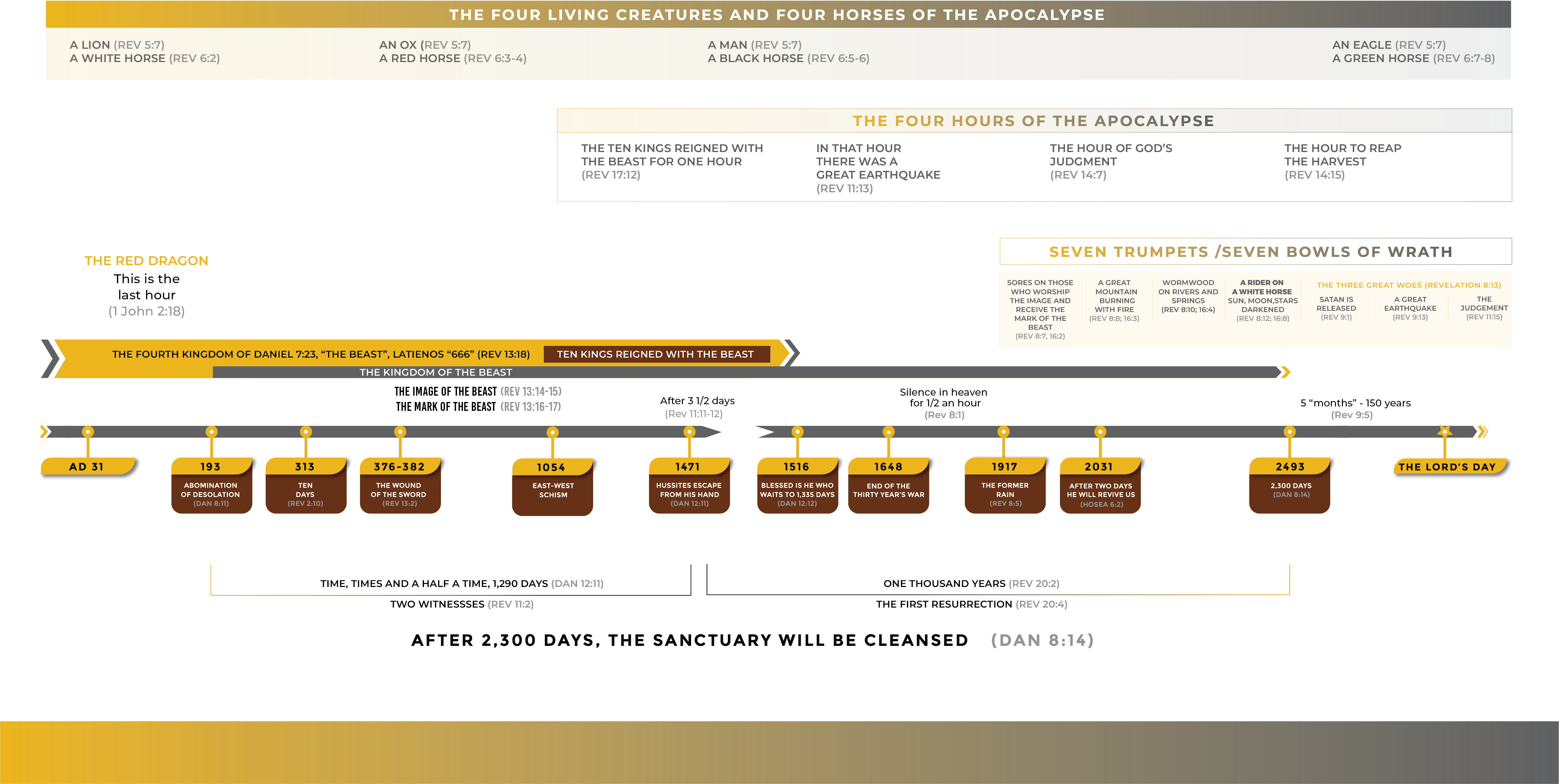
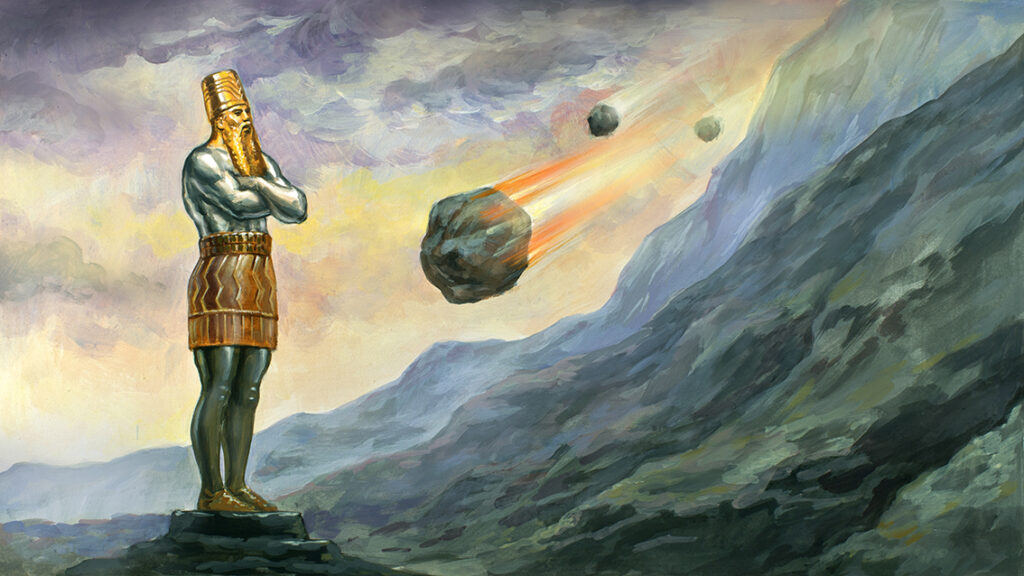
34. The Dream of King Nebuchadnezzar
In Daniel 2, King Nebuchadnezzar had a dream of an image with a head of gold, a chest of silver, a belly of bronze, and thighs of iron. Its feet were partly iron and partly clay.
A stone smashed the toes of the image, and it became a great mountain that filled the whole Earth.
None of the wise men were able to tell King Nebuchadnezzar the contents of the dream and explain their meaning, so he became furious and sent his soldiers to kill all the wise men in Babylon. But Daniel begged them for a chance to explain the dream. He prayed to God, who revealed to him the contents of the dream and their meaning, which he told the king:
“You O King … are the head of gold…. After you shall arise another kingdom inferior to yours … then another, a third kingdom of bronze, which shall rule over all the Earth…. And the fourth kingdom shall be as strong as iron inasmuch as iron it breaks in pieces and shatters everything…. Whereas you saw the feet and toes, partly of potter’s clay and partly of iron, the kingdom shall be divided — as you saw the iron mixed with ceramic clay, they will mingle with the seed.”
Daniel 2:37-43
The identities of the first four kingdoms were well known: Babylon, Persia, Greece, and Rome—the four kingdoms that kept Israel in captivity. These are the four beasts in Daniel 7. The ten toes in the image of Daniel 2 are the ten horns in Daniel 7.
And the stone that struck the image became a great mountain that filled the whole Earth
Daniel 2:35
The Protestant Reformers understood that the ten toes and ten horns were the ten states of Europe that came out of the Roman Empire and were united by the bishop of Rome. This gave them the confidence to break free from the power of the church, which was supported by the political power of Europe.
The stone that struck the image was Christ for Isaiah wrote, “Behold, I lay in Zion a stone for a foundation, a tried stone, a precious cornerstone….”Isa 28:16 The Spirit of Christ grew up into the mountain of the Lord’s House, which Isaiah described in the second chapter of his book.
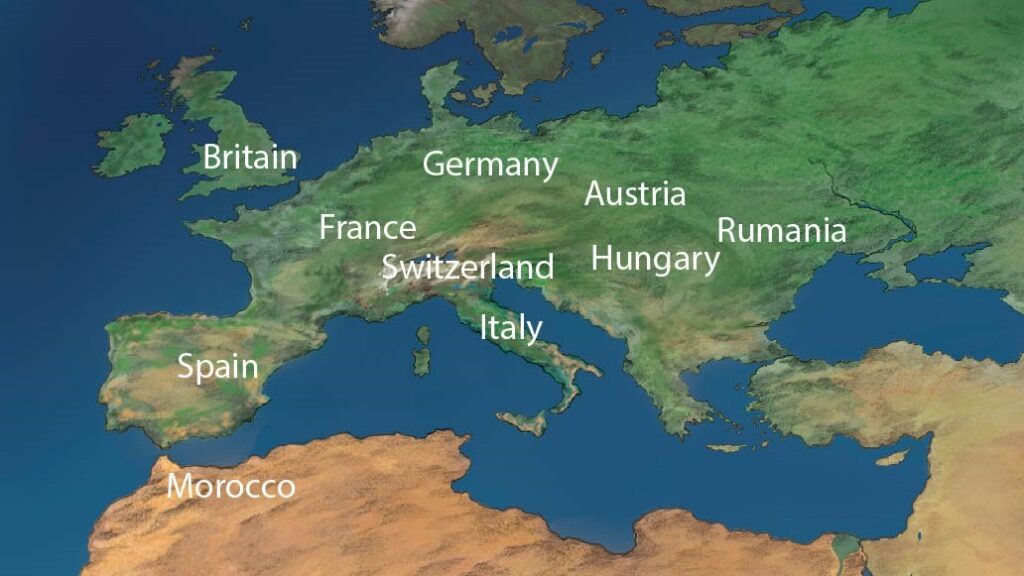
35. The Ten Kings
Dan 2:42-43, Dan 7:24, Rev 17:12
Daniel described the ten toes in the image of King Nebuchadnezzar’s dream. These were said to come out of the fourth beast, the Roman Empire, in Chapter 7. Of course, more than ten states came out of the Roman Empire, but at the time of the Reformation, only ten states had a relationship with the pope, who was called “the king of the north” in Chapter 11.
In the Book of Revelation, John said that these ten kings ruled “as one hour with the beast.” The Book of Revelation uses the expression of an “hour” seven times to describe a period of about 533 years, 1/12 of the human clock of 6,400 years. The ten kings ruled with the pope from the East–West Schism of 1054 until the 16th century. In Dan 7:8, we are told that the little horn subdued three states, which were the three Latin states of France, Italy, and Spain. They are still subdued by Catholicism today. In Chapter 9, Daniel calls these peoples “the people of the Ruler to come.”
they will not mingle with the seed of men, they will not adhere to one another.
Daniel 2:43
Daniel said the ten states would not adhere to one another in the seed of men. They were separated by language and culture. The Protestants had different ways of counting these states, but the most credible listing came from Machiavelli in 1532. He was an advisor to the pope and did not favor this prophecy. In his history of Florence, he described the following ten states as the “irruption of the Northern people upon the Roman territories:”1
• the Ostrogoths in Moesia (Romania);
• the Visigoths in Pannonia (Austria);
• the Sueves and Alans in Gascoign and Spain;
• the Vandals in Africa;
• the Franks in France;
• the Burgundians in Burgundy (Germany);
• the Heruli and Turingi in Italy;
• the Saxons and Angles in Britain;
• the Huns in Hungary; and
• the Lombards in Switzerland.

36. The Pope in Daniel
Most Protestants did not see the little horn in Daniel 7 and 8 as the power of Satan. They saw this little horn as the pope himself.
Not all Protestants, however, believed that the little horn in Daniel 7 was the pope. Some said that it was the pope while others, such as Martin Luther, said that it was the little horn in Daniel 8 that was the pope.
Daniel 8 describes the little horn as the power of Satan. Daniel compared the power of Satan to the power of Cyrus the Great and Alexander the Great, whom he also referred to as horns. Daniel said the little horn exalted itself as high as the Captain of the Armies, as high as Christ.
All Protestants understood that the king of the north in Dan 11:36-39 was the pope. The apostle Paul himself quoted this passage to warn the saints of the coming Antichrist, saying, [That Day (the Day of Christ)] “will not come unless the man of sin is revealed … who … sits as God in the temple of God, showing himself as God.”2 Thess 2:3-4
He will act against the strongest of fortresses with the help of a foreign god that he shall acknowledge … a god that his fathers did not know.
Daniel 11:38-39
The Angel said the pope would “magnify himself above every god” and “have no desire for women,”Dan 11:37 which described his celibacy. “He will act against the strongest of fortresses with the help of a foreign god that he shall acknowledge … a god that his fathers did not know.”Dan 11:38-39 This described the pope’s crusades against the fortresses of Islam. Muhammad, the prophet of Islam, said that the god of the Trinity was a god that the pope’s fathers did not know. It was a departure from the teachings of the Bible. In verse 39, the Angel said, “He will divide the land for gain.”Dan 11:39 The Catholic Church is still the largest non-governmental landowner in the world, owning 177 million acres of land.
37. The Beast Is Described
From all John’s descriptions, the Protestants saw the beast in Revelation 13 as none other than the pope.
On its heads were blasphemous names.Rev 13:1 — The pope took on names like “Christ on Earth” and “Father.”
Who can make war against the beast?Rev 13:4 — The pope was not the head of a state.
There was given to him a mouth speaking arrogant words and blasphemies.Rev 13:5 — Satan spoke through the bishop of Rome.
He was given authority to act for forty-two months.Rev 13:5 — The bishop of Rome held the saints in his hand for a time, times, and half a time.
He opened his mouth in blasphemies against God.Rev 13:6 — Through his blasphemous teachings
To blaspheme His name and His tabernacle that is those who dwell in heaven.Rev 13:6 — To blaspheme the saints of New Jerusalem.
All who dwell on the Earth will worship him.
Revelation 13:8
To make war with the saints and overcome them.Rev 13:7 — Just as Daniel also said
He was given authority over every tribe and people and tongue and nation.Rev 13:7 —He claimed to have the keys of salvation for every person.
All who dwell on the Earth will worship him.Rev 13:8 — All the false worshipers kissed the feet of the pope.
Everyone whose name has not been written from the foundation of the world in the book of life.Rev 13:8 — All those who worship the beast will not be saved.
Finally, the Angel of God said, “If anyone is destined for captivity, to captivity he goes. If anyone kills with the sword, with the sword he must be killed. Here lies the faith and patience of the saints.”Rev 13:10 — In 1522, Martin Luther wrote: “I will preach, speak, write, but I will force no one, for faith must be voluntary. Take me as an example. I stood up against the pope, indulgences, and all papists, but without violence or uproar.”2
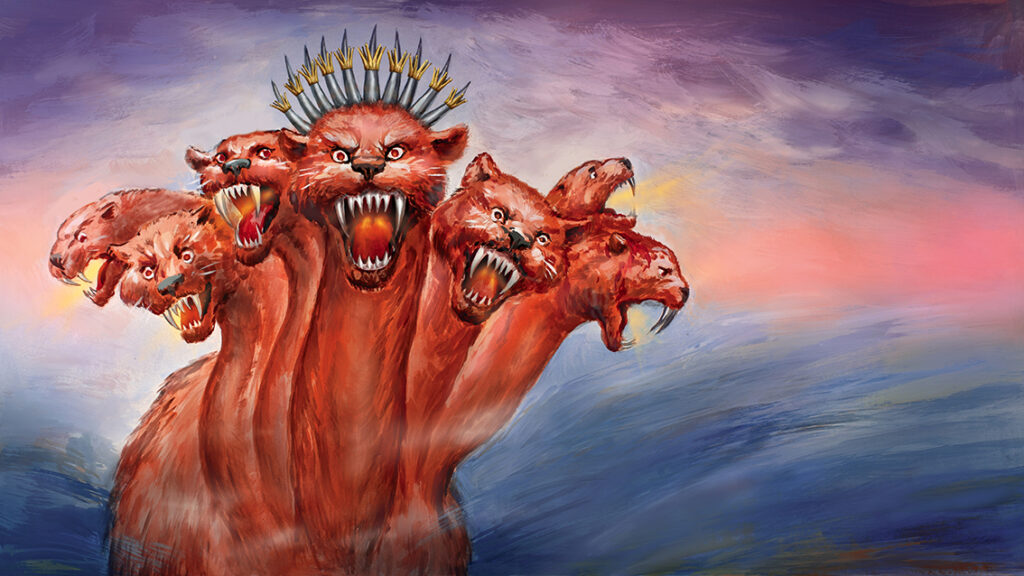
38. The War with the Lamb
Dan 2:34, Dan 8:25, Zech 4:1-14, Rev 11:8, Rev 17:13-14
Before the Reformation, the ten kings of Western Europe oppressed the witnesses of Christ. They not only oppressed them, but they also killed them.
John said, “These [ten kings] have one purpose, and give their authority and power to the beast — These [ten kings] will make war with the Lamb and the Lamb will overcome them because He is Lord of lords and King of kings, and those who are with Him, called chosen and faithful.”Rev 17:13-14
The apostle John described Christ as a lamb more than 20 times in the Book of Revelation — first in Rev 5:6, where he “saw a lamb standing as if slain, having seven horns and seven eyes.”
These seven horns and seven eyes were described as the spirits that “go to and from throughout the earth” in Zech 1:10; and Zech 4:10. They report to the Spirit of Christ, the Archangel, who is now called a lamb.
the Lamb will overcome them because He is Lord of lords and King of kings
Revelation 13:14
The Spirit of Christ overcame the ten kings as a lamb that was slain, through the testimony of His martyrs, called witnesses. From the Greek word for “witness” we get the English word “martyr.” Many of Christ’s witnesses became martyrs. John said, “Their dead bodies will lie in the street of the great city, which is mystically called Sodom and Egypt, where also their Lord was crucified.”
These witnesses were called two olive trees by Zechariah, who said, they “stand beside the Lord of the whole earth.”Zech 4:14 They will overcome “not by might or by power but by My Spirit [the Spirit of Christ].”Zech 4:6
Daniel said that Satan would “be broken without human means.”Dan 8:25 The Spirit of Christ was the stone that was cut out of the mountain “without human hands”Dan 2:34 in Nebuchadnezzar’s dream. It shattered the ten toes of the great image.
The whole world became a courtroom as these two witnesses testified against the beast. Daniel said, “The court shall be seated, and his dominion shall be taken away.”Dan 7:26
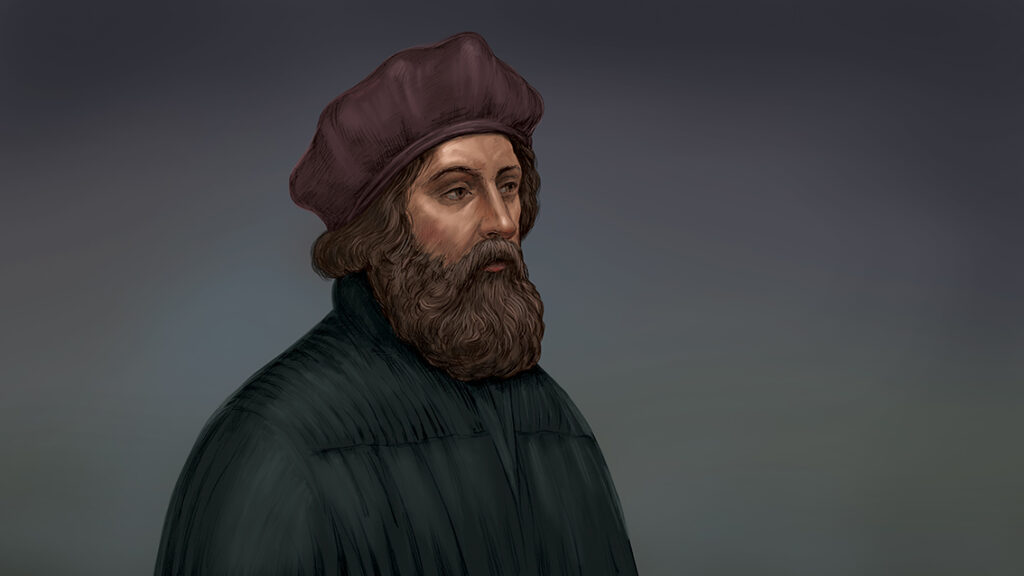
39. The Rejection of Prophecy
Most Evangelical Christians today understand “a time, times, and half a time” differently from the 18th-century Protestants. In his 18th-century dissertation on the Book of Revelation, Bishop Newton stated that all the Protestants of his day recognized that “a time, times, and half a time” did not equal 1,260 days but 1,260 years, which began when the saints came under the power of the bishop of Rome.3
The Protestants did not understand the abomination of desolation, the event that put the saints in the hand of the Antichrist, but they clearly understood the kings and kingdoms that Daniel prophesied in Chapter 2 and 7. They easily saw the relationship between the ten kings and the pope. The ten kings were the ten states of Europe that came out of the Roman Empire, and the little horn was the Antichrist, whom they identified as the pope. This understanding gave them the confidence to break free from the Catholic Church, which the Book of Revelation called “a great harlot.”
the words are closed, and sealed up until the time of the end
Daniel 12:9
Today, however, few Protestants believe in the interpretation of the Book of Revelation we have described. Most Evangelicals now say that “a time, times, and half a time” literally means a 42-month tribulation.
Why is the modern interpretation so different from the view that was universally acknowledged only 200 years before? In the 19th century, the Seventh Day Adventist Church successfully argued that if the pope was “the beast,” then the “mark of the beast” was the changing of God’s commandment to keep holy the Sabbath day. As a result, many Protestants abandoned the understanding of “the beast” that they had held for centuries.
Modern Evangelicals say that the beast has not yet appeared and that “the mark of the beast” is a microchip that will be implanted in people’s foreheads, but the 19th-century Protestants simply quoted from the last chapter of Daniel, which said that Daniel’s prophecy was sealed until the end times.

